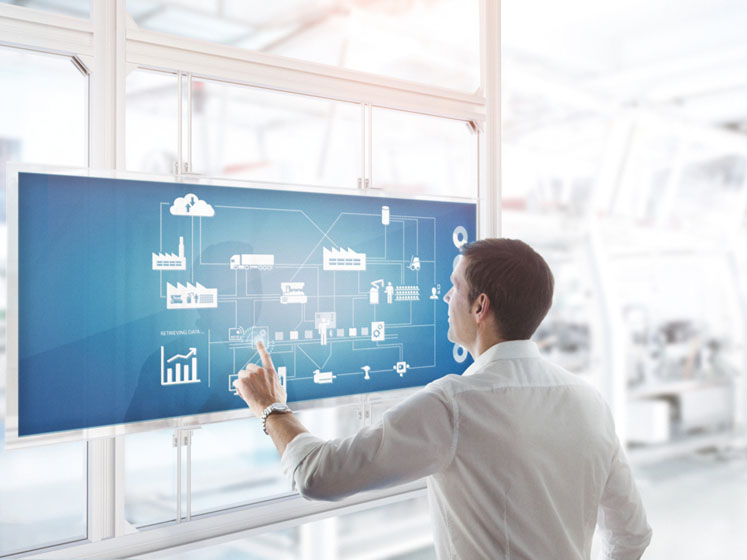Against this backdrop, medical device organisations have had to prepare themselves for compliance deadlines and adapt to new technologies. Looking ahead now, the busy period doesn’t appear to be going away anytime soon. From January, I expect to see a sharp rise in organisations feeling the pressure of the looming IVDR deadline in May 2022.
Here, technology will again prove its worth and will be on standby to lend a digital hand to businesses yet to make progress towards reaching compliance. I see artificial intelligence (AI), 3D rendering and cloud systems taking their place under the medical device spotlight — and predict that they will become invaluable assets for industry organisations around the world.
AI goes under the medical device microscope
Medical device organisations have been heavily reliant on manual labour for some time, but its arduous nature and high risk of human error — alongside continual expense — has caused businesses to rethink how they conduct certain processes. Part of this rethink comes in the form of AI, the art of equipping a machine to undertake tasks or make decisions in a way that mirrors human intelligence and behaviour.1
Accelerated by the COVID-19 pandemic, recent years have seen AI make its move away from being a “concept” and into a reality. Take the dermatology space for example. Here, AI has been involved with patient treatment and diagnosis whereby its ability to read body scans has led to the discovery of cancerous cells, both earlier on and more accurately.2

Previously, AI had only been used in simple operations; but, as it is increasingly used in more significant procedures, regulations surrounding the technology have become front and centre for governing bodies. The first major factor is protecting patient safety. AI, when combined with human intelligence, can significantly reduce errors when compared with human labour alone.
Humans are naturally prone to making mistakes; but, in a highly regulated industry such as medical devices, mitigating as much risk as possible is crucial. Many believe AI exists to replace human intelligence, but it is actually most effective when the two are combined — as in the case of medical device management when it can lead to major benefits regarding enhanced error handling and performance management.
With predictive capabilities, AI can read and foresee text, language, symbols and more assets that are associated with the label of a medical device. It can then populate this data onto a spreadsheet — autonomously speeding up laborious tasks that will take much longer by humans.
But the value of the data it produces will very much depend on the quality of the software or technology used. For example, a major Danish medical device company specialising in ostomy and wound care uses Kallik’s Veraciti solution within its factory operations, which, as a result, has helped the company to achieve significant benefits.
From speed adoption gains to productivity increases, the company has been able to complete more than 80,000 projects and hold in excess of 1.6 million files in the system since adopting the solution in May 2012. Most recently, it changed 90,000 labels in just 6 months with only six people — an impossible task without the helping hand of technology.
Going forward, Kallik is working with an AI partner to spot label features, automating and accelerating processes by cutting out 2-3 steps of manual labour. Let’s put it into perspective: one million labels would take 300 million hours of labour to change if there was no technology involved.
3D rendering helps organisations go the full 360°
Another emerging technology that I see increasing in usage in 2022 is 3D rendering — a software solution designed to take user-created 3D models and place them into fully realised 3D environments or images. In the label and artwork space, 3D rendering can generate labels to put on the product and produce a 360-degree view of what it will look like on the bottle, product or even shelf before it goes to market.

Traditionally, the software is only used in retail settings; but, recent interest from medical device companies has seen a major increase in requests by marketing teams within these organisations.
The request comes again from a timing perspective. With 3D rendering, marketing teams have more free time for downstream editing for different types of print press rather than simply pulling in another person to do the job on their own.
But, similar to the AI story, 3D rendering will work best alongside human labour; simply relying on the computer alone will not be effective.3 For example, the artist will need to choose the best colour for the materials as well as define the correct lighting features to make the most realistic render possible.
Cloud takes operational efficiency to new heights
Last but not least, my third and final prediction is the further adoption of cloud-based technologies. Research by TechJury has suggested that, by 2025, the global public cloud computing market will be worth more $800 billion, with 70% of companies already using the cloud set to increase their budgets in the upcoming years.4
Here at Kallik, we have been using Amazon Web Services (AWS) to host our Veracti platform for 18 months. The benefits have been highly noticeable, so I’m not surprised to see that, in 2020, more than 50% of enterprises moved their workloads to AWS.5
This was the largest enterprise public cloud adoption figure for the year, which I don’t see changing in 2022. With our old legacy systems, adding a new customer to the system would be slow; but, as our customer base has continued to increase, the new platform hasn’t shown any signs of slowing down either. With enhanced reliability, using AWS has given us the ability to dramatically scale as a business, as well as our customers.
Cloud solutions offer automatic upgrades and reliability testing — which is exactly what AWS has been doing for Kallik and its customers. Now, with less time spent on manual upgrades, team members are able to focus on future technologies and prospects that will be critical for business operations in the upcoming years.
A digitally focused future for medical devices in 2022
With a new year comes new regulation deadlines and a countdown for organisations to reach compliance dates. With the upcoming May 2022 IVDR deadline, alongside the postponed MDR September 2022 deadline, medical device organisations must look to technology and software if they wish to reach compliance in time.
Fortunately, technologies such as AI, 3D modelling and cloud-based solutions are ready and waiting to help — and I particularly see these three trends gaining great traction throughout the medical device space in the upcoming year. By no means are they there to replace human intelligence, but simply enhance it in areas such as productivity, reduced errors and speed.
References
- http://starfishmedical.com/blog/medical-device-artificial-intelligence/.
- www.medicaldevice-network.com/features/can-regulators-keep-up-with-ai-in-healthcare/.
- www.medical-artist.com/our-services/3d-medical-devices-illustration/.
- https://techjury.net/blog/how-many-companies-use-cloud-computing/#gref.
- www.statista.com/statistics/511467/worldwide-survey-public-coud-services-running-application/.




